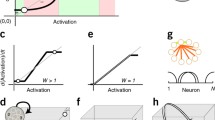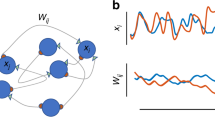Abstract
The interaction of memory structures and retrieval dynamics is discussed. A mathematical model for associative free recall is presented to support the view that the organization of simple processing units plays an important role in the retrieval of memory traces. Computer simulations show that “flexibility” and “fidelity” of the dynamics strongly depend on the network structure, the amplification and decay parameters, and the noise term.
Similar content being viewed by others
References
Anderson JR (1976) Language, memory, and thought. Erlbaum, Hillsdale NJ.
Anderson JR (1983a) The architecture of cognition. Harvard University Press, Cambridge Mass.
Anderson JR (1983b) A spreading activation theory of memory. J Verbal Learn Verbal Behav 22:261–295.
Anderson JR, Bower GH (1973) Human associative memory. Winston, Washington DC.
Anderson JR, Pirolli PL (1984) Spread of activation. J Exp Psychol: Learn Memory Cogn 10:791–798.
Collins A, Loftus E (1975) A spreading activation theory of semantic processing. Psychol Rev 82:407–428.
Collins A, Quillian M (1969) Retrieval time from semantic memory. J Verbal Learn Verbal Behav 8:240–248.
Deese J (1965) The structure of associations in language and thought. Johns Hopkins Press, Baltimore.
Érdi P (1988a) On the ultrametric structure of semantic memory: scope and limits. In: Trappl R (ed) Cybernetics and systems '88. Kluwer, Dordrecht.
Érdi P (1988b) Structural aspects of the (natural and artificial) semantic memory. In: Sydow A, aet al. (eds) System analysis and simulation: mathematical research, vol 46. Akademie-Verlag, Berlin.
Érdi P, Grőbler T, Marton P (1991) On the double architecture of the semantic memory. In: Carvallo M (ed) Nature, cognition and system, vol 2. Kluwer, Dordecht (in press).
Hebb DO (1949) The organization of behavior. Wiley, New York.
Huberman BA, Hogg T (1987) Phase transitions in artificial intelligence systems. Artif Intell 33:155–171.
Kihlstrom JF (1987) The cognitive unconscious. Science 237:1145–1452.
McClelland JL, Rumelhart DE (1981) An interactive activation model of context effects in letter perception: Part 1. An account of basic findings. Psychol Rev 88:375–407.
Morton J, Bekerian D (1986) Three ways of looking at memory. In: Sharkey NE (ed) Advances in cognitive science, vol 1. Howrood, Wiley, Chicester, New York.
Palermo DS, Jenkins JJ (1964) Word association norms. University of Minnesota Press, Minneapolis.
Pléh Cs (1991) The renaissance of association in contemporary cognitive psychology. Annales Universitatis Scient de L Eötvös Nom, Sectio Philosophica (in press).
Postman L, Keppel G (1970) Norms of word association. Academic Press, New York.
Quillian MR (1968) Semantic memory. In: Minsky M (ed) Semantic information processing Mit Press, Cambridge Mass pp 227–270.
Ratcliff R, McKoon G (1981) Does activation really spread? Pscychol Rev 88:454–462.
Rumelhart DE, McClelland JL (1986) Parellel distributed processing: explorations in the microstructure of cognition, vols 1 and 2. MIT Press, Cambridge Mass.
Rumelhart DE, Smolensky P, McClelland JL, Hinton GE (1986) Schemata and sequential thought processes in PDP models. In: Rumelhart DE, McClelland JL: Parallel distributed processing: explorations in the microstructure of cognition, vol 2. MIT Press, Cambridge Mass.
Smolensky P (1986) Neural and conceptual interpretation of PDP models. In: Rumelhard DE, McClelland JL (eds) Parallel distributed processing: explorations in the microstructure of cognition, vol 2. MIT Press, Cambridge Mass.
Squire LR (1982) The neuropsychology of human memory. Ann Rev Neurosci 5:241–273.
Tulving E (1972) Episodic and semantic memory. In: Tulving E, Donaldson W (eds) Organization of memory. Academic Press, New York.
Tulving E (1985) How many memory systems are there? Am Psychol 40:385–398.
Underwood G (1979) Memory systems and conscious processes. In: Underwood G, Stevens R (eds) Aspects of consciousness, vol 1. Academic Press, New York.
Author information
Authors and Affiliations
Rights and permissions
About this article
Cite this article
Grőbler, T., Marton, P. & Érdi, P. On the dynamic organization of memory. Biol. Cybern. 65, 73–79 (1991). https://doi.org/10.1007/BF00197292
Received:
Accepted:
Issue Date:
DOI: https://doi.org/10.1007/BF00197292




